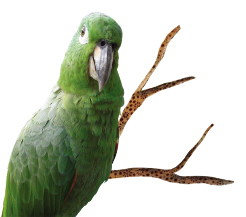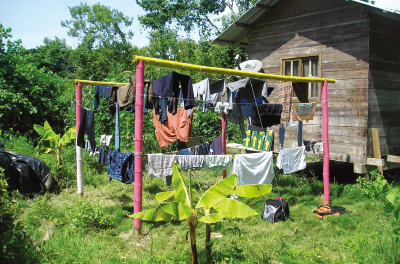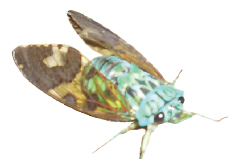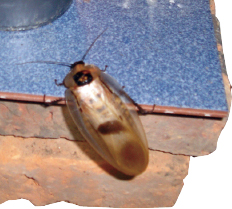The House of the Spirits
평소 릭 러핀은 자동차를 거의 타지 않는다. 일 년에 한 번 해외여행을 갈 때 비행기에서 이산화탄소가 발생하기 때문에 평소 그만큼 이산화탄소를 덜 배출하기 위해서란다. 올해도 해외로 떠난 릭은 파나마, 멕시코, 콜롬비아를 거쳐 에콰도르 해안의 삼림보호 구역에서 한 달 간 나무심기 등 자연보호 활동을 했다. 독사나 독거미 등 주변에 위험한 동물도 많고, 곰팡이와 진흙투성이인 정글 속에서 호된 고생을 했지만, 자연의 보호에 작게나마 도움을 줄 수 있어 어느 때보다 보람된 여행이었다고 한다.
글 | 릭 러핀Rick Ruffin 번역 | 김성훈 기자 디자인 | 김현정 기자

에콰도르는 건기와 우기, 두 계절이 존재하는 곳이다. 건기는 5월부터 11월까지, 우기는 12월부터 4월까지이다. 건기에는 하루 종일, 아니 밤까지 계속 비가 온다. 낮에 해가 뜨긴 하지만, 우리가 땀에 젖은 채 손을 휘둘러 모기를 쫓고 얼굴에 묻은 진흙을 닦아내며 생활하고 일하다 보면, 이곳이 얼마나 습한 곳인지를 알게 해 줄 만큼만 뜬다. 내가 정글 속에서 지낸 한 달 동안 거의 매일 밤 비가 왔다. 낮이면 적어도 서너 시간씩 해가 모습을 드러내긴 했지만, 숲 속은 항상 어두웠기 때문에 어슴푸레한 빛만 원숭이가 노는 나무들보다 약 60m 상단의 숲의 지붕을 겨우 뚫고 들어올 뿐이었다.
내가 한 달 동안 생활했던 정글에는 전기도 들어오지 않고 불빛도 없었다. 음악도, 인터넷도, 전화기를 비롯한 어떤 통신수단도 없었고, 냉장고나 얼음도 없었다. 백만 개의 별들처럼 밤하늘을 밝힌 반딧불들이 쉴 새 없이 깜빡였고, 주변의 어둠 속에서는 사자처럼 울어대는 원숭이들의 울음소리가 끊임없이 들려왔다.
박쥐도 한 마리 있었는데, 색깔이 하얀 탓에 다들 그 박쥐를 ‘마시멜로 박쥐’라고 불렀다. 박쥐는 낮에는 거꾸로 매달려 있다가 저녁이 되면 먹이인 벌레를 찾아 날개를 퍼득이며 날아갔다. 이 박쥐가 주위를 날아다니는 모습은 전혀 보이지 않았지만, 때때로 보름달이 뜨는 밤이면 박쥐가 날면서 만든 그림자가 땅 위를 맴도는 것을 볼 수 있었고, 날개를 퍼득이는 소리도 들을 수 있었다.
그런가 하면 내가 정확하게 구별할 수 없는 다른 소리들도 있었다. 낯선 새들의 울음소리, 천장에 붙어 꿈틀대는 도마뱀붙이들, 어둠 속에서 개골개골 울어대는 개구리들, 거기에다 끊이지 않고 배경처럼 깔리는 벌과 매미들의 붕붕대는 소리가 그것이었다. 매미들은 낮이고 밤이고 울어댔다. 대나무로 만든 오두막 안에는 벌들이 윙윙대는 소리만 가득했다.
내가 생활했던 그 대나무 오두막을 나는 ‘영혼의 집’이라고 불렀다. 언젠가 읽은 적이 있는 라틴 아메리카의 작가 이사벨 아옌데가 쓴 동명의 소설에 대한 경의를 담아 붙인 이름이다.
영혼의 집에는 최대 24명까지 들어갈 수 있는 규모였지만, 처음 2주 반 동안 나는 그곳에서 홀로 밤을 보냈다. 매일 저녁 6시 30분이 되면 어두워져 아무것도 보이지 않기에 나는 헤드램프를 쓰고 그 빛으로 글을 읽곤 했다. 주변은 칠흑같이 캄캄한 나머지 나는 마치 새벽 4시에 비틀거리며 침대에서 나와 화장실로 갈 때처럼 앞이 하나도 보이지 않았다. 마치 장님이라도 된 것처럼 나는 두 손으로 앞길을 더듬으며 천천히 걸어야 했다. 의료보험도 들어놓지 않았기에 길을 갈 때 발을 헛디디지 않도록 각별히 조심했다.
오두막에는 나보다 먼저 그곳을 다녀간 다른 자원봉사자들이 두고 간 책들이 한 무더기 있었고, 첫 주 동안 나는 헤드램프에서 나오는 불빛을 의지해 그 책들을 거의 모두 읽었다.

한 무리의 젊은이들이 태국에서 겪은 일을 담은 <비치The Beach> 같은 모험기冒險記들이 있었다. <뉴욕타임즈> 베스트셀러 목록에도 올랐던 미스터리 스릴러물과 데이빗 세다리스라는 미국의 수필가가 쓴 유머러스한 수필집도 있었다. 하지만 나로 하여금 사물을 넓게 볼 수 있게 한 책은 1960년대 적도 아프리카에서의 삶(생존이라고 하는 게 더 적합할지 모른다)을 그린 바바라 킹솔버의 소설 한 권이었다.
<포이즌우드 바이블>이라는 이 책을 읽으면서 나보다 더 고립되고, 두렵고, 외롭게 사는 사람들이 있다는 사실을 금방 알 수 있었다. 사실 그들이야말로 우리의 상상 이상으로 외로운 삶을 살고 있었다.
얼마 후 미국 위스콘신 주에서 온 젊은 미국인 생물학자 여러 명이 이곳으로 왔는데, 자기네가 아마존 강에서 지독한 과학자들을 만났던 이야기들을 들려 주었다. 그 과학자들은 애벌레들이 몇 주 또는 몇 달 간에 걸쳐 어떻게 번데기를 찢고 하늘로 올라가는지를 관찰하기 위해 곤충들이 자기 피부에 알을 낳게 한다고 했다.
‘영혼의 집’은 지어진 지 8년 정도밖에 되지 않았지만 완전히 허물어지고 있다. 집에 가득한 흰개미들이 집을
“아미고스(스페인어로 ‘친구들’이란 뜻).”비고떼는 서까래를 가리키며 대답했다. “쏜 떼르미따스(스페인어로 ‘흰개미들이 있다’라는 뜻).” 그는 너무 당연한 것 아니냐는 투로 말했다. 물론 나 역시 애초에 그런 어리석은 질문은 하지 말았어야 하는 것처럼 대답했다. 어디서 누군가가 집에 대해 조치를 취하지 않으면 그 집은 곧 완전히 무너질 것이었다. 그냥 두었다가는 해먹, 침대, 식탁, 기둥, 서까래들이 잔뜩 설치된 이 집은 금방 자연으로 되돌아갈 것이다. 당연히 누군가가 어디서 어떻게든 이를 바꾸기 위해 뭔가를 하지 않으면 덩굴과 나무, 이끼, 식물로 뒤덮일 것이다.
내가 한 달 간 지내며 봉사했던 250헥타르 규모의 라로 로오르Lalo Loor 건림乾林보호구역은 에콰도르에 남은 몇 안 되는 건림지대 중 한 곳이다. 에콰도르 해안지역 대부분이 축산업으로 돌아섬에 따라, 건림지대의 규모는 이전의 2% 규모로 줄어들었고, 원래의 98%는 사라진 상태다.
이곳이 ‘건림’, 즉 마른 숲이라고 불리는 이유는 일 년 중 특정 기간에는 이곳의 진흙은 먼지로 바뀌고, 시내는 완전히 말라붙으며, 몇몇 나무들의 잎이 누렇게 말라 땅에 떨어지기 때문이다. 하지만 내가 ‘영혼의 집’에 머문 한 달 간은 매일 밤 비가 내렸다. 빗물과 먼지가 뒤범벅이 되어 옷과 신발이 온통 엉망이 된 채로 일해야 했다.
하지만 곰팡이는 특히 골치 아픈 존재였다. 돌이켜 보면, 날마다 옷이 한 벌씩 곰팡이가 슬어 옷을 버려야 했기 때문에 그만큼 충분한 옷을 가지고 오지 않았던 점이 아쉽다. 한번은 아내 사진을 꺼냈는데 얼굴 부분에 곰팡이가 슬어 엉망이 되어 있었다. 나는 그 사진을 버려야 했다. 나는 곰팡이가 가죽에 가장 쉽게 슨다는 사실을 알았다. 곰팡이는 순식간에 가죽을 망쳐놓는다.
내가 영혼의 집을 떠나게 된 것은 오두막으로 가는 길가에 있는 구멍 속에 살던 커다란 타란튤라 독거미 때문은 아니다. 군함 크기만한 딱정벌레들이나 내 얼굴로 쉴 새 없이 달려들던 나방들 때문도 아니다. 위생관념이라고는 전혀 없던 에콰도르인 요리사나 음식물 쓰레기통 속에서 미친 듯이 날뛰던 바퀴벌레들 때문도 아니다. 정글 속 길을 지날 때마다 얼굴에 들러붙던 거미줄 때문도 아니고, 아침마다 내게 인사를 건네던 식탁 위의 톱밥 무더기 때문도, 우리가 봉사하던 곳이 진흙탕 투성이라 금방 신발이나 장화를 벗겨버리곤 해서도 아니다.
인근 마을 주민들의 70%가 문맹이기 때문도, 어떤 식으로든 전기를 이용할 수 없어서도 아니다. 곰팡이 때문이다. 곰팡이 때문에 나는 밤의 무더위 속으로, 영혼의 집 주변을 둘러싸고 있던 어둠의 한가운데로 달려들어갈 수밖에 없었고, 결국 다시는 돌아오지 않았다. 그런데도 내가 영혼의 집에서 보낸 한 달은 그만한 가치가 있는 시간이었을까? 그럼, 물론 그만한 가치가 있는 시간이었다.

Ecuador is a place of two seasons: dry and wet. The dry season runs from May until November, and the wet season runs from December to April. During the wet season it rains every day—or night, I should say. During the day the sun comes out just enough to remind us all what a humid place it is in which we live, and we work on, drenched in sweat, swatting mosquitoes and rubbing mud from our faces. In the month that I was there it rained almost every night, and the sun came out—at least for a few hours—almost every day, but in the jungle it was always dark, a half-light that barely penetrated the forest canopy 60 meters above, where monkeys played among the trees.
I lived in the jungle for one month with no electricity and no lights. There was no music, no internet, no phone, no communication, no refrigerator, and no ice. There was instead the constant blinking of the fireflies, which lit up the night sky like a million stars, and the constant howl of the monkeys, which growled like lions from the darkness all around.
We had a bat, a “marshmallow bat,” the others called it, because it was white. It hung from the ceiling during the day and took to the air each evening in search of insects to eat, beating the heavy air with its wings. I could never see this bat when it was flying around, but on nights when there was a full moon sometimes I could see its shadow racing across the ground and hear its wing beat as it flew by.
There were other sounds too, which I never fully understood. Strange bird calls, geckos beckoning from the ceiling, frogs croaking in the dark, and the constant background drone of bees and cicadas. The cicadas would sing during the most of the day and most of the night. Inside the bamboo hut the constant buzzing of the bees would dominate.
I called the bamboo hut in which I lived the House of the Spirits. I called it that in deference to a novel I once read, a book by the Latin American writer Isabelle Allende.

There was quite a collection of books, left behind by other volunteers before me, and in the first week I read almost all of them, by the light my battery powered headlamp could provide.
There were adventure books like The Beach, about a bunch of young adults going crazy in Thailand. There was a mystery thriller from the New York Times bestseller list and a book of humorous essays written by an American essayist named David Sedaris. But the book that put everything into perspective was a novel about life—or better yet survival—in Equatorial Africa, set in the 1960s and written by Barbara Kingsolver.
By reading this book, The Poisonwood Bible, I quickly learned that there were other people who were more isolated, more afraid, and more alone than me. In fact, they were more isolated than one could ever imagine.
Later, when a bunch of young American biologists arrived from Wisconsin, they told stories of the more stoic scientists they had met in the Amazon and how they would allow insects to lay eggs under their skin, in order to watch the larvae hatch from their own flesh weeks, or months later, and take to the sky.
The House of the Spirits had been built almost eight years ago, but was now coming apart at the seams. It was full of termites and they were eating it from within. The tables at which we ate were covered with a thin film of sawdust every morning. On the third day that I was there I asked Bigote, the cook, where all the sawdust was coming from. “Amigos (My friends made it),” he said, pointing to the rafters. “Son termitas (I mean the termites).” He told me, as if this were only totally natural. Of course, I responded, as if I never should have asked such a stupid question in the first place. Soon, this house would all come crashing down, unless someone, somewhere, did something to arrest the process. This habitation of so many hammocks and bunks and tables and beams and rafters would soon revert to nature, if left alone. Soon, it would be covered by vines and trees and moss and plants, unless, of course, someone, somewhere, somehow, did something to change the course of history.
The 250 hectare Lalo Loor Dry Forest Reserve in which I lived and worked for one month is one of the few remaining areas of “dry forest” left in Ecuador. Places such as this now occupy only 2% of their former area, as most of coastal Ecuador has been turned over to livestock production, and 98% of the original “dry forest” is gone.
The reason this place is called “dry forest” is because at some point during the year the mud turns to dust, the streams all dry up, and the leaves on some of the trees turn yellow and fall to the ground. But for the month that I lived in the House of the Spirits it rained every night. I worked in a matrix of water mixed with dirt that coated all of my clothes and shoes.
But the mold was especially bad. In retrospect, I should have brought more clothes that I could afford to throw away, as each day I would discover yet another item of clothing that had been ruined by mold, and that I would have to throw away. At one point I found a picture of my wife and noticed that her face had been ruined by mold. I had to throw that picture away. I found that mold takes most readily to leather. Mold will ruin leather in a second.
If any one thing made me flee the House of the Spirits it was not the spiders or the huge tarantula that lived in a hole alongside the path to the bamboo hut. It was not the battleship sized beetles, nor the moths that constantly flew into my face. It was not the utter lack of hygiene displayed by the Ecuadorian cook, nor the cockroaches running amok in the food bins. It was not the spider webs that I
It was not the 70% illiteracy in the nearby village nor the lack of electricity of any kind. It was the mold. The mold sent me running into the heat of the night, into the heart of darkness that surrounded the House of the Spirits, never to return again. But was my month long sojourn at the House of the Spirits worth it? Oh yes, of course it was.

1996년부터 한국에 거주하고 있는 릭 러핀은 브라질계 미국인으로 현재 동해에서 한국인 아내와 살고 있다. 15년 넘게 한국 대학생들을 대상으로 영어를 가르치고 있으며 문화, 환경, 교육 등 다양한 분야에 관심이 많다. 월스트리트저널을 비롯한 세계 여러 매체에 글을 기고했으며, 저서로 <정치가들이 말해주지 않는 것들>이 있다.

